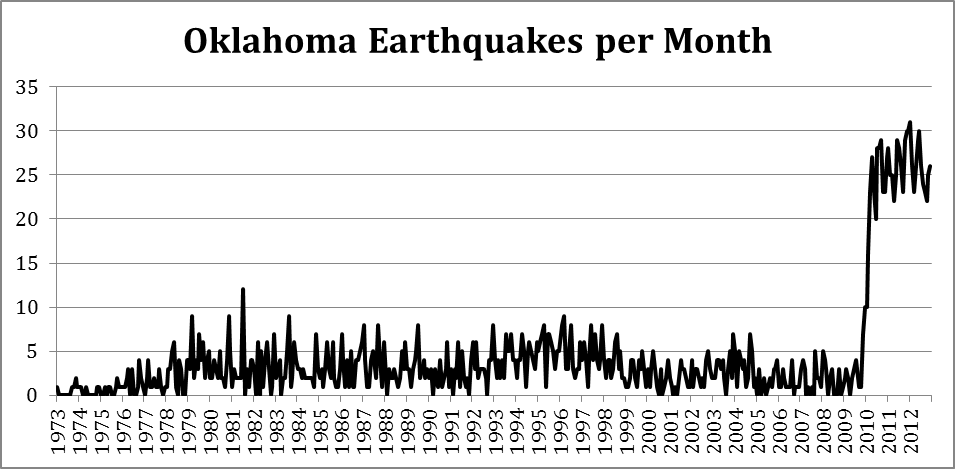Is the Use of Hydraulic Fracturing by the Energy Industry Causing More Frequent Earthquakes in Oklahoma?
In recent years there has been an increased concern with the number of earthquakes in Oklahoma. Local and national news coverage has increased, but is that because earthquakes are happening more often in the state? My research looks at available data about the incidence of earthquakes in Oklahoma, to see what can be learned about shifts in their frequency and when they have occurred. One obvious issue is whether Oklahoma earthquakes have become more frequent as hydraulic fracturing techniques have taken hold in the energy industry. The answer obviously has important ramifications for public policy – but current data make it hard to tell.
Hydraulic Fracturing and Earthquakes
“Massive hydraulic fracturing” is a method of extracting natural gas from shale formations, so called because the process uses water along with some form of lubricating liquid and sand or other particles to hold open fractures in rock that allow more gas to escape. Fracturing materials are pumped into a well site to put pressure on the shale and cause the fractures that allow natural gas to escape. When the shale fractures due to the pressure from materials pumped in, natural gas encased in the shale escapes and can be captured on the surface.
First implemented on a large scale in the late 1990s, massive hydraulic fracturing was first used in Oklahoma in 2003. Subsequently, massive hydraulic fracturing has been blamed for a recent increase in the number of seismic events in Oklahoma and the rest of the middle of America. Pinpointing trends in the frequency of earthquakes in Oklahoma takes on added urgency in this context, because if Oklahoma quakes became significantly more frequent after the onset of massive hydraulic fracturing in 2003, such a shift would be evidence for fracturing as a contributing cause.
The Challenge of Measuring and Explaining Earthquake Frequency
The Oklahoma Geological Survey provides a list of all of the earthquakes in Oklahoma from 1882 to the present. The number of days in a month with an earthquake event serves as the variable of interest for my effort to investigate changes in the distribution of earthquake activity. The available data are not tied to geographic areas, like for example the distribution of police stations in a city or a grid of where a quarterback’s throws land on a football field. Instead, the analysis tracks numbers of quakes over time and seeks to determine varied ups and downs that occur as a matter of course over the years. Once we know how changes in the numbers predictably occur from year to year, then we can look for departures from the normal pattern. However – and this is an important point – even if a shift in trends is found, we still have to ask whether that is because of actual changes in earthquake frequencies or simply because of improved technologies for measuring earthquakes.

At first glance, a chart of Oklahoma earthquake frequencies makes it look like the onset of massive hydraulic fracturing was associated with much more frequent quakes. However, when I inquired about any changes in the way earthquakes were measured after 2009, the Oklahoma Geological Survey reported that two new seismic survey stations came on line in 2010, making it easier to capture data on quakes. So we just cannot tell for sure whether changes after 2010 were due to better measurement or fracturing (or both).
Ideally, the Oklahoma Geological Survey would provide data that would allow researchers to determine which stations sensed the earthquakes. But that information is not available now, so of necessity I refocused my preliminary statistical analysis of trends and break points in trends on the data collected by consistent methods for the months between January 1973 and December 2009, in order to avoid including the change to the data generating process deriving from collection rather than changes to seismic activity. The exact technique I used (a Bayesian statistical method) was developed by statisticians Bradley Carlin, Alan E. Gelfand, and Adrian F. M. Smith to explore the processes associated with trends in accidents in coal mines.
My results offered some surprises. Starting in January 1978, there was an increase in the average number of days with an earthquake event in a month, but processes of massive hydraulic fracturing were not used then in Oklahoma. I cannot even be sure that the 1978 shift was not due to a change in the process used to collect data about earthquakes. In another round of analysis, I found another small shift from October 1998 – this time, a reduction from 5.6 to 2.6 earthquake days per month. But this is a reduction, not an increase, and is not in any event coincident with the advent of hydraulic fracturing techniques.
In sum, my research so far cannot document any increase in Oklahoma earthquakes associated with the use of massive hydraulic fracturing. My research shows the possibilities for teasing out actual shifts in earthquake frequency. But until Oklahoma geologists provide information to allow researchers to differentiate between actual earthquake events and changes in measurement techniques, we cannot properly test claims that fracturing increases earthquake frequency.
